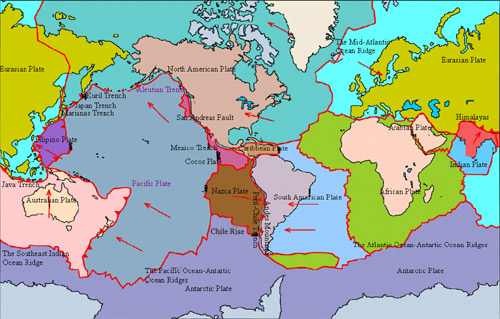FAQ for Earthquake
12. What is "the theory of plate tectonics"?
The theory of plate tectonics is mainly used to describe the structure of the outermost layers of the Earth and to explain the cause of earthquakes.
The outermost part of the Earth is called the lithosphere, which is made up of cold, rigid and moveable rocks. The average thickness of the lithosphere is about 100 km. Below the lithosphere lies the asthenosphere, which is made up by liquefied materials with high viscosity. Under high temperature and high pressure, these liquefied materials develop plasticity and make the lithosphere flow above it.
The basic concept of plate tectonics is that the lithosphere is divided into a few nearly rigid plates, including the Eurasian plate, American plate, African plate, Indian plate, Pacific plate, Antarctic plate, and a few other notable minor plates (see the picture below). These plates are subjected to different tension, pressure, gravity, and convection in the mantle. Hence, these plates move slowly every year by several centimeters, with different speeds of movement. This results in the existence of differences in the relative velocities between neighboring plates. Most earthquakes, volcanoes, and orogenesis are the result of the interactions among the neighboring plates.
There are three types of plate boundaries:
| (1) | Divergent boundaries: A phenomenon of the Earth's crust extension, tension, and fracture movement. At the mid-ocean ridge location, neighboring tectonic plates mutually separate and produce the new lithosphere. Its material comes from the upper side of the mantle, and is produced by fusing. The Earth's crust extends to both sides due to the tension. The earthquake often takes place along the boundaries of divergence, and the depth of the hypocenter is within 100 kilometers. |
| (2) | Convergent boundaries: When two plates mutually collide at their intersection, the heavy plate inserts itself underneath the light one (by approximately a 30°~ 45° inclination angle). As such, the old lithosphere vanishes into the mantle, and this insertion is called the subduction zone. Because of the friction between two plates, earthquakes frequently occur along the subduction zone, which forms a seismic zone. The depths of the hypocenters may vary from very shallow to about 700 kilometers. The location near Hualien, Taiwan, is where the convergent boundary of the Eurasian plate and the Philippine Sea plate meet. Therefore, the frequency of the earthquake activities over the Hualien region is extremely high. |
| (3) | Conservative boundaries: They neither produce the new lithosphere nor cause lithosphere vanishing. When any two neighboring tectonic plates act on each other with derailing friction, they produce earthquakes with shallow focal depths. The East Rift Valley Fault in Taitung is an examples of conservative boundaries between the Eurasian plate and the Philippine Sea plate. |

-
- Earthquake Information
- Disastrous shocks
- Earthquake Report
- Earthquake Factsheets
-
- Tsunami
- Tsunami Information
-
- Disaster Prevention
- Precautions for Earthquake
- Precautions for Tsunami
- FAQ for Earthquake
-
- Observation network
- Observation network
- monitoring station searching

